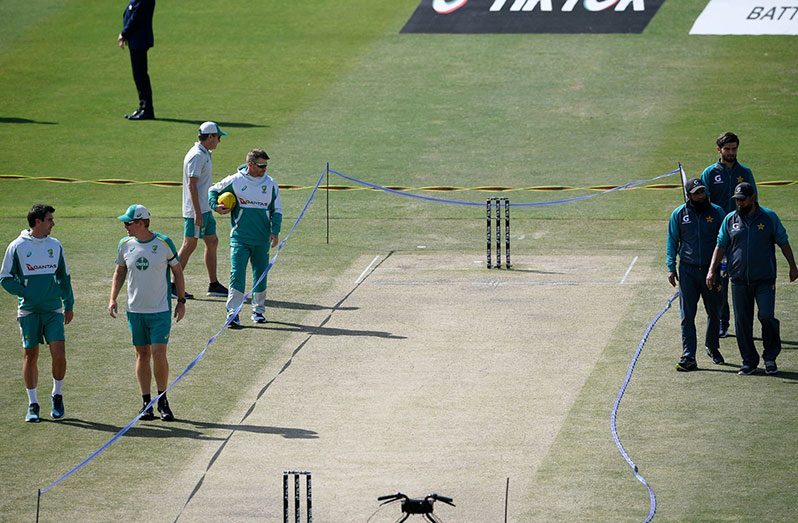THE match referee who put the MCG on notice for an unacceptable pitch four years ago will have the final say on whether a “dead” Rawalpindi deck that has produced just 11 wickets in four days will receive a similar sanction.
Steve Smith lamented the lifeless surface produced for the highly-anticipated Benaud-Qadir series opener, which is on track to finish as one of the least bowler-friendly Test matches this century.
The International Cricket Council’s (ICC) chief referee Ranjan Madugalle was the appointed match referee in Melbourne for the 2017 Ashes Test against England when he took the rare step of formally labelling the drop-in pitch that produced 24 wickets in five days as “poor”.
Should Madugalle (who is also officiated in this Test) reach a similar verdict in Rawalpindi, the ground will receive three demerit points. A venue that is handed five points over a five-year period will be suspended from hosting international cricket for 12 months.
Pakistan’s Nauman Ali, whose domestic team Northern plays in Rawalpindi, acknowledged the surface has played significantly different to previous wickets at the venue.
Smith, who made 78 from 196 balls, said the track offered nothing for fast bowlers and only marginal assistance for spinner
“It’s pretty benign,” Smith told reporters. “There’s not a great deal of pace and bounce in it for the seamers, that’s for sure.
“I think the spinners have offered a little bit. When you’ve hit the right length there’s been a bit of natural variation, and when you get it out a bit wider into the rough there’s a bit there as well.
“But outside of that, I don’t think there’s a great deal on offer for the fast bowlers … It’s a pretty benign, dead wicket.
“There’s not very much bounce, not a great deal of pace and if you’re bowling stump to stump and setting straight fields it’s not overly easy to score … but also probably difficult to get out as well.

Smith also played in that 2017-18 Ashes Test at the MCG, scoring a second-innings century and had been even more forthright on that surface, of which he said: “I just don’t think it’s good for anyone.”
The ongoing match’s current average of 84.09 runs per wicket is the highest recorded since the Sri Lanka-Bangladesh Test in Galle in 2013 (84.89).
The fewest wickets to fall in a Test not significantly affected by rain (minimum 330 overs bowled for the match) this century is 17.
In guidelines implemented by the ICC at the beginning of 2018 (coincidentally only days after the MCG bat-a-thon in December 2017) the governing body decreed that Test pitches should “allow all the individual skills of the game to be demonstrated by the players at various stages of the match
A pitch is deemed “poor” if it “displays little or no seam movement or turn at any stage in the match together with no significant bounce or carry, thereby depriving the bowlers of a fair contest between bat and ball”.
The ICC also suggests that “if anything, the balance of the contest between bat and ball in a Test match should slightly favour the bowling team”.
The only pitch that has been deemed “poor” since the introduction of the new ICC rules was the 2018 Wanderers Test between South Africa and India which was at the other end of the scale to the Rawalpindi deck.
That surface had raised concerns over player safety due to volatile pace and bounce, with speedsters Jasprit Bumrah, Morne Morkel and Kagiso Rabada proving a nightmare for batters.
Australia had been expecting Rawalpindi to provide the most seam-friendly conditions of their three-Test tour of Pakistan, with drier pitches then expected in Lahore and Karachi
Pacemen took all but eight of the 40 wickets to fall in the most recent Test at the venue in February last year, a 95-run win for Pakistan over South Africa in which quick Hasan Ali was player-of-the-match with a 10-wicket haul.
A year on, left-arm spinner Nauman resorted to bowling over the wicket to Australia’s right-handers, at the encouragement of spin coach Saqlain Mushtaq, to target bowler’s footmarks.
“The pitch was slow and there was no turn but I tried to utilise the rough area and bowl in the key areas, eventually I succeeded,” said Nauman, the Test’s most successful bowler with four victims having dismissed both Smith and Cameron Green with the over-the-wicket ploy.
“After yesterday’s bowling, we had a long discussion with Saqlain Mushtaq and the plan was to use the rough areas as there was no turn in the pitch.
“Normally in ‘Pindi’ the pitch is different due to weather and the pitch is not very dry and always helps the batters (Cricket.com.au)



.jpg)








